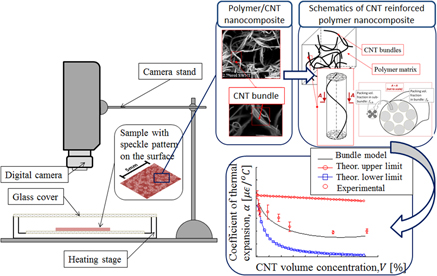Published online by Cambridge University Press: 19 June 2017

The thermal expansion behavior of polymer carbon nanotube (CNT) nanocomposites was investigated, and a micromechanical model was proposed to explain the highly nonlinear dependence of the coefficient of thermal expansion of the nanocomposite with CNT content for the CNT/polyimide nanocomposite. The microscopic analysis of CNT/polyimide matrix showed homogeneous dispersion of bundles composed of CNTs. Therefore, the proposed model to predict the thermal expansion behavior of the nanocomposite considered a random, homogeneous distribution of CNT bundles with a hierarchical arrangement of helical CNTs within the polymeric matrix. The CNT bundle morphology influenced the thermal expansion response of the nanocomposite through (i) bundle volume fraction and (ii) degree of helicity, affecting thermo-mechanical properties of the bundle. The effective, homogenized, properties of CNT bundles were determined by the elasticity based solution of the layered cylinder model. Bundle effective properties were used in the micromechanical model implementing the homogenized strain rule of the mixture expression to predict the thermal expansion behavior of nanocomposite in a wide range of CNT volume contents. The proposed micromechanical analytical model was found to correlate closely with the experimental results for polyimide/CNT nanocomposite films as measured using a digital image correlation method.
Contributing Editor: Linda S. Schadler